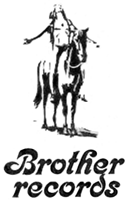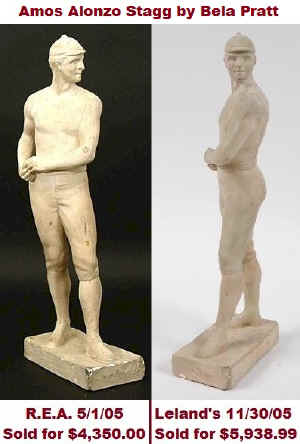|
|
APPEAL
TO THE GREAT SPIRIT
By
Cyrus Edwin Dallin, 1908 |
|

Appeal
to the Great Spirit located at
front
entrance to Museum of Fine Arts Boston
|
|

Dallin
Signature |

Dedication
Plaque |

Founders
Mark |
CYRUS
E. DALLIN
In
1995 the Rockwell Museum in Corning N.Y. mounted an
exhibition of Dallin's work titled "Cyrus E. Dallin: His
Small Bronzes and Plasters" According to an essay in
the exhibition catalog by Museum Director Kent Ahrens,
Dallin initially exhibited a plaster cast of Appeal to the
Great Spirit" in Baltimore in 1908. He then had the
Jaboeuf & Rouard foundry in Paris cast a bronze edition.
That edition won a medal at the 1909 Salon. Apparently,
according to the essay, that same example was shipped across
the Atlantic and exhibited outside the National Academy of
Design in New York City in 1911. Thereafter it somehow made
it's way to Boston and was placed on a temporary pedestal
outside the MFA until money could be raised for it's
procurement. Apparently, according to the Ahrens essay, even
after the statue made it's way to MFA grounds the deal was
teetering and other cites were vying for it. The essay
provides that in the end Dallin sold Appeal to the MFA in
1912 for $12,000.00 with the stipulation he could make
reproductions "not to exceed three feet in their
greatest dimension"...The essay goes on in extensive
detail how many  were cast by the Gorham foundry in three
different sizes totaling 399. Also in 1912 Dallin obtained a
copyright for "Appeal". The essay supplies as much
that by the 1920's the image had been widely reproduced and
Dallin unsuccessfully litigated copyright infringement.
Speaking of infringement...you'd
never guess who else helped themselves to Appeal to the
Great Spirit...The Beach Boys...They started their own
record label called Brother Records in 1966 and chose Appeal
as their logo. were cast by the Gorham foundry in three
different sizes totaling 399. Also in 1912 Dallin obtained a
copyright for "Appeal". The essay supplies as much
that by the 1920's the image had been widely reproduced and
Dallin unsuccessfully litigated copyright infringement.
Speaking of infringement...you'd
never guess who else helped themselves to Appeal to the
Great Spirit...The Beach Boys...They started their own
record label called Brother Records in 1966 and chose Appeal
as their logo.
On
the subject of Gorham, if you ever run into a Gorham bronze you should
be able to I.D. it by the first letter in the marking which
is a "Q". My first bronze work was a trophy plaque
of a polo match by Gorham, and was where I first learned of
their "Q" mark.
|
c1888
STATUE OF JOHN L. SULLIVAN
Copyright by
C. Dallin Jan, 12. 1888
Plaster
cast, 28 inch tall |
|
|
|

|

c1888
photo of Sullivan statue |

|
|
|
|
SPORTS
SCULPTURE
I'm
always on the watch for antique sports sculpture, especially works by recognized American
artist. Back in 2004 I stumbled onto a plaster statue of
John L. Sullivan by Dallin. I didn't end up with it  but just
learning of it was meaningful. Speaking of sports sculpture
by name artist, Bela Pratt was another out of the blue
surprise. In May 2005 I saw a plaster statue of Amos
Alonzo Stagg by Pratt in the Robert
Edward Auction of that year. Then again in November the
same year I saw another
Pratt statue of Stagg in Lelands.com. If you click the
photo to the left I've stitched the two works for a
comparison. It's a little hard to tell for sure but the
nicks on the bases appear to differ, therefore I think they
were two different examples. It's remarkable Pratt
reportedly sculpted the work while both he and Stagg were
classmates at Yale, making it a very early example of his work!
After Yale Pratt went on to a full and remarkable career in
sculpture producing more than 180 works. From 1898 to 1917
he was head of the sculpture department at the School of the Museum of Fine
Arts Boston. For some reason I didn't notice any works by
him my visit. I guess I must have just missed them. but just
learning of it was meaningful. Speaking of sports sculpture
by name artist, Bela Pratt was another out of the blue
surprise. In May 2005 I saw a plaster statue of Amos
Alonzo Stagg by Pratt in the Robert
Edward Auction of that year. Then again in November the
same year I saw another
Pratt statue of Stagg in Lelands.com. If you click the
photo to the left I've stitched the two works for a
comparison. It's a little hard to tell for sure but the
nicks on the bases appear to differ, therefore I think they
were two different examples. It's remarkable Pratt
reportedly sculpted the work while both he and Stagg were
classmates at Yale, making it a very early example of his work!
After Yale Pratt went on to a full and remarkable career in
sculpture producing more than 180 works. From 1898 to 1917
he was head of the sculpture department at the School of the Museum of Fine
Arts Boston. For some reason I didn't notice any works by
him my visit. I guess I must have just missed them.
THE
WRAP
Wrapping
up our visit to the MFA I'll mention one last standout
work...and it was a sports related one...I speak of a c1910
sterling silver presentation punch bowl awarded for a polo
match in Pasadena Ca. The  work
measured about 25" wide by 12" tall and was made
by Clemens Friedell in a partially hammered Art Nouveau
style. The inscription which was done in relief read: "Challenge
Polo Trophy - Presented to William J. and Frank C. Hogan.
Below was a relief of a polo player going for the ball.
Around the bowl was relief of foliage and at least one polo
mallet. It was one of the finest polo presentation pieces
I've seen particularly for being from the last of the Art Nouveau
era. Interesting it started it's life in Pasadena and now
sits on display in Boston. Clemens
Friedell who I never heard of till now is quite
interesting as well...Born in Louisiana, grew up in Vienna and was apprenticed
as a silver maker there, moved to Texas at age 17. 1901
moved from Texas to Providence Rhode Island where he worked
for Gorham. 1911 moved to Pasadena Ca where he set up
shop..... work
measured about 25" wide by 12" tall and was made
by Clemens Friedell in a partially hammered Art Nouveau
style. The inscription which was done in relief read: "Challenge
Polo Trophy - Presented to William J. and Frank C. Hogan.
Below was a relief of a polo player going for the ball.
Around the bowl was relief of foliage and at least one polo
mallet. It was one of the finest polo presentation pieces
I've seen particularly for being from the last of the Art Nouveau
era. Interesting it started it's life in Pasadena and now
sits on display in Boston. Clemens
Friedell who I never heard of till now is quite
interesting as well...Born in Louisiana, grew up in Vienna and was apprenticed
as a silver maker there, moved to Texas at age 17. 1901
moved from Texas to Providence Rhode Island where he worked
for Gorham. 1911 moved to Pasadena Ca where he set up
shop.....
continue
to page 12
|